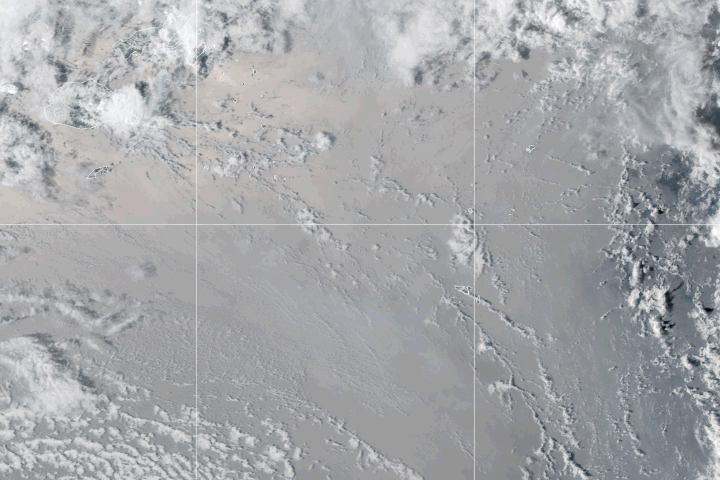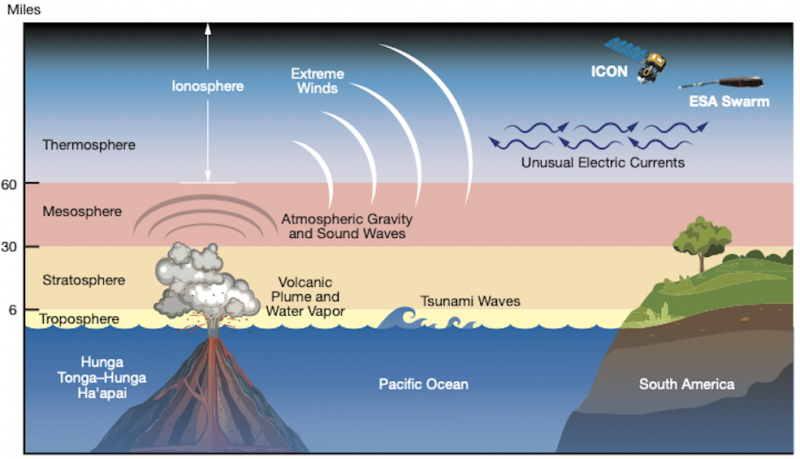
Tonga was as big as Krakatoa
The volcanic blast that destroyed the uninhabited island of Hunga Tonga Ha’apai on January 15, 2022, is now officially the largest explosive eruption of the 21st century so far. And it was the largest since the 1991 eruption of Mt. Pinatubo in the Philippines. The size of the Tonga explosion makes it the largest ever recorded by modern sensor technology. Measurements of the pressure wave the blast created – which traveled around the world four times over a six-day period – was equivalent to the 1883 eruption of the infamous Krakatoa.
Biggest boom ever recorded
The explosion created an event that has never been seen before in recorded history. Tonga blew ejecta well into the upper atmosphere, to the edge of space. It created a cloud that covered an area approximately half the size of France.
The underwater volcano erupted inside a caldera already 500 feet (150 meters) below the sea surface. It deepened its underwater cavity by about half a mile (750 meters).
Researchers Piero Poli and Nikolai M. Shapiro at the Institut des Sciences de la Terre (CNRS/Université Grenoble Alpes/IRD/Université Savoie Mont Blanc) used a new method of remote sensing to gauge the January 15 eruption. A statement from CNRS said of the unexpected results:
The authors show that the Hunga Tonga eruption ejected a volume of around 10 km³ (~2.4 miles³), making it the largest explosive eruption of the twenty-first century, equivalent in strength to that of the devastating eruption of Pinatubo (Philippines) in 1991.
The research wasn’t intended merely to measure volcanic explosions. The work could revolutionize the study of volcanic eruptions and reduce their impacts, according to the announcement about the new way of analyzing already available data:
This method should make it easier to study large explosive eruptions in remote regions. Its reactivity, of the order of an hour, could help to predict the areas likely to be affected by ash, which can disrupt human activities both on the ground and in the air.
The researchers published the study on April 20, 2022, in Geophysical Research Letters.
Volcano holds another surprise
As if being the biggest explosive volcanic event ever recorded wasn’t enough, Hunga Tonga Ha’apai had another surprise in store for researchers. Marine geologist Kevin Mackay of New Zealand’s National Institute for Water and Atmospheric was astonished to find the volcano that produced the blast is still mostly intact, with sea life thriving just 15 km (9 miles) away. The venerable Australian broadcast outlet 9News reported his reaction:
With an explosion that violent – the biggest ever recorded – you would expect that the whole volcano would have been obliterated, but it wasn’t.
Mackay said while the volcano appeared intact, the seafloor showed some dramatic effects from the eruption:
There is fine sandy mud and deep ash ripples as far as 50 kilometers (30 miles) away from the volcano, with gouged valleys and huge piles of sediment.”
Blast echoed around the world four times
A team of international researchers from 17 countries, using data from global barometers, found the pressure wave created by the destruction of Hunga Tonga Ha’apai reverberated across the planet four times over nearly a week. The Lawrence Livermore National Laboratory, which participated in the study, put the findings this way:
The atmospheric wave data showed that the eruption propagated for four passages around the Earth over six days. NASA determined that the eruption was “hundreds of times more powerful than the atomic bomb dropped on Hiroshima.”

The eruption was equivalent in energy to the eruption that destroyed Krakatoa in the 19th century and makes other recent eruptions look small by comparison. Work done at Lawrence Livermore was focused on so-called Lamb waves – acoustic-gravity waves traveling along Earth’s surface:
Measurements of Lamb wave peak-to-peak pressure amplitudes as a function of distance indicated that the atmospheric pressure pulse generated by the Hunga event is comparable to that of the 1883 Krakatoa eruption. The Hunga signal amplitudes are over an order of magnitude larger than those generated by the 1980 Mount St. Helens eruption.
The group’s findings were published in the journal Science, on May 12, 2022.
Hunga Tonga Ha’apai is still erupting
Those who experienced the eruption first-hand not only witnessed the biggest explosion ever measured, they also survived the greatest number of lightning strikes associated with a single natural event. The explosion generated tsunamis that devastated the Kingdom of Tonga, clearing many islands of all signs of life. One of the first on the scene was volcanologist Shane Cronin of the University of Auckland. He offered his description of the destruction:
When I arrived and went to the west, the scenes of damage were apocalyptic. With no resorts, buildings or trees remaining, the coast is now more vulnerable than ever.
Cronin said Hunga Ha’apai is now about 25 percent of its pre-eruption size, and less than 10 percent of Hunga Tonga remains. And, the eruption is ongoing, though unlikely to pose a danger in the near future. He said:
There’s still an ongoing source of magma at Hunga, so future activity is inevitable. But I would expect there to be none of this scale for many hundreds of years … the caldera is so deep now that small events won’t have an impact.
The small eruptions still going on are like geysers. Because the caldera is really deep, they won’t cause a problem away from the volcano. We went across them in a boat many times and didn’t even notice them until we saw them on the sonar. They are like a safety valve on a pressure cooker.
Bottom line: The Hunga Tonga-Hunga Ha’apai eruption was the largest ever recorded, and the magma is still flowing.
The post New record: Tonga volcano biggest of 21st century first appeared on EarthSky.
0 Commentaires